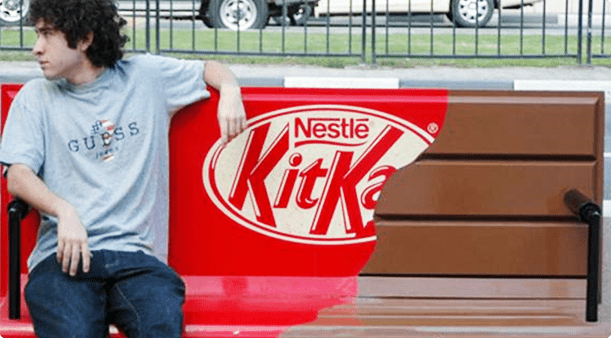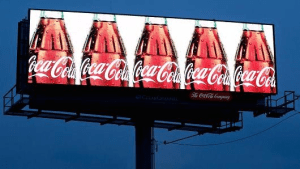Introduction: Rethinking Ambient Advertising in a Mobile, Cluttered World
Ambient advertising is often described as bold, surprising, and unconventional. From stairs turned into piano keys to massive murals or floor decals in airports, ambient ads are designed to turn heads by showing up where no one expects them.
But what if we told you that static installations are only half the story?
While traditional ambient advertisements deliver shock value, in-hand ambient advertising delivers stickiness, portability, and scale. We’re talking about branded coffee sleeves, pizza boxes, pharmacy bags, and even coasters—formats that live in people’s hands, homes, and moments of real attention.
In this blog, we’ll explore why portable touchpoints aren’t just a cost-effective spin on ambient advertising—they’re the future of smart brand engagement.
Ambient Advertising Is Evolving—And Going Portable
The original purpose of ambient ads was to break through clutter by placing your brand in a contextually surprising space. That’s why brands have wrapped escalators, buses, and even elevator floors.
But here’s the challenge with traditional ambient advertisement tactics:
They’re stationary in a world that’s always moving
They often rely on passive impressions (walk-bys, glances)
Their cost per interaction is high, especially in high-footfall areas
They’re hard to scale across neighborhoods, regions, or zip codes
In contrast, in-hand ambient ads travel with the consumer—they follow the coffee cup to the office, the pizza box into a dorm room, or the pharmacy bag into the home medicine cabinet.
Ambient advertising doesn’t need to be stuck to a wall to be memorable—it needs to be held, noticed, and used.
Why In-Hand Ambient Ads Outperform Static Media
Let’s break down the advantages of portable ambient advertising over fixed installations:
Higher Dwell Time
A branded coffee sleeve stays in a consumer’s hand for 10–15 minutes. A pharmacy bag may sit in a home for days. Compare that to a floor sticker someone glances at for three seconds.
Physical Engagement
Touch increases memory. The science of embodied cognition proves that physically interacting with a branded object enhances recall far more than visual exposure alone.
Scalable Targeting
You can drop 10,000 branded pizza boxes in specific zip codes. Try doing that with a subway stairwell mural.
Distraction-Free Context
In-hand ambient ads often appear when consumers are relaxed and focused: drinking coffee, eating dinner, filling a prescription—not rushing through a metro station.
The Psychology Behind Effective Ambient Advertisement Formats
When a consumer receives an in-hand item like a branded sleeve or bag, their brain perceives it differently from a billboard or bus ad.
Here’s why:
It’s perceived as useful, not promotional
It has tactile weight, triggering deeper neural encoding
It enters personal space—the most trusted layer of brand proximity
It can be shared, extending reach to families, roommates, or colleagues
In essence, in-hand ambient ads activate emotional and behavioral pathways that static installations simply can’t match.
Ambient Advertising Formats That Move With the Consumer
Let’s explore the most effective in-hand formats for ambient advertising campaigns:
🧴 Pharmacy Bags
Perfect for healthcare brands, insurance companies, and wellness startups. They reach consumers during care-related moments and can include QR codes, co-pay discount offers, or wellness content.
☕ Coffee Sleeves
Ideal for financial services, education platforms, or tech apps. These sleeves offer captive attention in clinics, campuses, or coworking spaces.
🍕 Pizza Boxes
Great for family products, local services, or entertainment brands. Each box reaches multiple viewers—usually in a relaxed, shared setting.
🍻 Bar Coasters
Used effectively for beverage, lifestyle, or dating apps. Coasters can deliver repeated impressions during a long dwell-time setting like bars or lounges.
Each of these formats combines context, repetition, and portability—core ingredients of effective ambient advertising.
Real-World Results: How In-Hand Ambient Ads Drive Engagement
Let’s look at three brand campaigns that used in-hand ambient formats instead of static OOH—and won big:
📍 Healthcare Brand – Pharmacy Bags
A regional insurer ran a campaign using pharmacy bags in urban zip codes. Each bag included a QR code linking to a plan comparison tool.
Scan rate: 4.2%
Brand recall: +38% over digital-only campaign
CPA: 36% lower than programmatic ads
📍 Beverage App – Bar Coasters
A craft beer delivery app placed coasters in 80 bars. Each included a QR for first-time orders.
Redemption rate: 19%
Repeat customer rate: 43%
Cost per impression: ~$0.12
📍 Food Subscription Brand – Pizza Boxes
Branded pizza box ads were distributed in suburban neighborhoods with a promo for first orders.
New subscriptions: 317 per 10,000 boxes
Social shares: 400+ organic posts
Household reach per unit: 2.7x
That’s ambient advertising with actual ROI—not just viral potential.
When to Choose In-Hand Ambient Advertising Over Static Installs
Campaign Goal | Static Ambient Ads 🚫 | In-Hand Ambient Ads ✅ |
Increase brand recall | Low effectiveness | High due to tactile memory |
Drive QR scans or app downloads | Low interaction | High scan-to-download ratio |
Reach niche local demographics | Low precision | Hyper-targetable by zone |
Maximize dwell time | Short glance exposure | 10–60+ minutes per interaction |
Budget flexibility | High minimum investment | Scalable at any volume |
Unless your campaign is about stunning visuals in one location, in-hand ambient ads provide more flexibility, more impressions, and more engagement.
Conclusion: Ambient Advertising Is Stronger When It’s Held, Not Just Seen
The ambient advertising world loves to celebrate the spectacular. Giant wall wraps, bus stop transformations, and subway surprises dominate case study reels.
But if your brand’s goal is recall, action, and real-world engagement, the smartest move isn’t louder visuals—it’s smarter placement.
In-hand ambient advertising gives your brand:
Longer exposure times
Targeted distribution
Tactile memory activation
More ROI per dollar spent
Because in a world of visual clutter, the most powerful ambient advertisement might be the one your customer holds in their hand—right before they take action.
https://youtube.com/shorts/eOK_Bq5TxlY?si=-n6tXIoi5eq0GXPl






